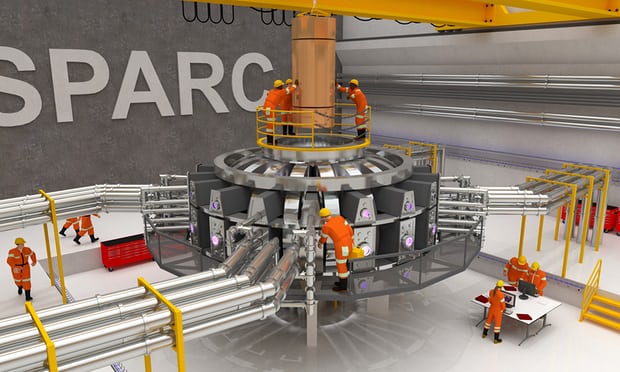Edison was big on clean energy, exclaiming in 1910 how much he would like to see solar energy become a reality…
“I’d put my money on the sun and solar energy.
What a source of power! I hope we don’t have to
wait until oil and coal run out before we tackle
that. I wish I had more years left.”
-Thomas Edison
 Today we are seeing that happen, with solar-electric panels springing up on buildings and commercial structures; and now, something else solar-wise is very promising—nuclear fusion. Unlike nuclear fission which is the cleaving or splitting of heavy atoms to produce lots of energy, fusion is the squeezing together of very light atoms like hydrogen to produce helium, thus releasing vast amounts of energy. To be precise, fusion is the process that our sun uses to covert hydrogen to helium. In its core, the Sun fuses 620 million metric tons of hydrogen to helium each second.
Today we are seeing that happen, with solar-electric panels springing up on buildings and commercial structures; and now, something else solar-wise is very promising—nuclear fusion. Unlike nuclear fission which is the cleaving or splitting of heavy atoms to produce lots of energy, fusion is the squeezing together of very light atoms like hydrogen to produce helium, thus releasing vast amounts of energy. To be precise, fusion is the process that our sun uses to covert hydrogen to helium. In its core, the Sun fuses 620 million metric tons of hydrogen to helium each second.
Our sun is powered by the nuclear fusion process-MIT is trying to contain that process in a magnetic bottle for use on earth
Elusive as the fusion process has been over the last 60 years, MIT in cooperation with a private entity is hopeful that within the next 15 years, fusion will arrive in time to make a big difference in reducing fossil fuel use, greatly ameliorating global climate change. The secret MIT ingredient for success involves a new class of high-temperature superconductors they believe will facilitate the world’s first fusion reactor that produces more energy than needs to be put in to get the fusion reaction going.
The MIT team believes they can achieve this by using new superconducting materials to produce ultra-powerful magnets, one of the main components of a fusion reactor. The entire fusion process must be maintained inside a magnetic bottle of sorts as the temperature is enormously high, on par with those at the center of the sun, far stronger than any materials we could use to contain it. Commonwealth Fusion Systems and MIT in partnership with an Italian energy company, Eni, and $50 million in supporting funds are ready to make this energy dream come true.

The MIT SPARC fusion reactor test assembly
A newly available superconducting material – a steel tape coated with a compound called yttrium-barium-copper oxide, or YBCO – has allowed scientists to produce smaller, more powerful magnets. And this potentially reduces the amount of energy that needs to be put in to get the fusion reaction off the ground.
The experimental reactor being developed is designed to produce about 100MW of heat. While it will not turn that heat into electricity, it will produce, in pulses of about 10 seconds, as much power as is used by a small city. Scientists anticipate the output would be more than twice the power used to heat the plasma, achieving the ultimate technical milestone: positive net energy from fusion.
The fusion reaction is carbon-free, does not create greenhouse gases or produce hazardous radioactive waste of the sort made by conventional nuclear fission reactors. Did you hear that Thomas….clean, virtually unlimited energy….just like you had hoped for 110 years ago!
Editor’s Deep Dive
- www.fusionforenergy.europa.eu/understandingfusion/
- www.en.wikipedia.org/wiki/Fusion_power
- www.world-nuclear.org/information-library/current-and-future-generation/nuclear-fusion-power.aspx
Thomas Edison said, “I find out what the world needs. Then I go ahead and try to invent it.”

Left: Intel-Edison module now available world-wide for developers. Right: The “Tommy” award given by the Edison Innovation Foundation.

